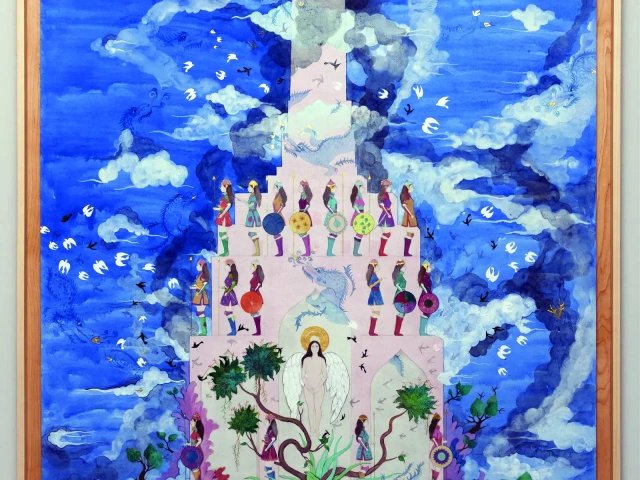When Brooklyn-based Pakistani artist Hiba Schahbaz paints, the boundaries between reminiscence, mythology, and the feminine physique blur into one thing directly intimate and otherworldly, in line with a report by Vogue.
Her newest exhibition, 'Hiba Schahbaz: The Backyard', now open on the Museum of Up to date Artwork North Miami, marks her first solo museum present and brings collectively greater than 70 works that hint her journey from Karachi's quiet bedrooms to the partitions of an American museum.
The exhibition, curated by Jasmine Wahi, unfolds like a visible poem constructed round 4 components — earth, air, hearth, and water. Wahi describes it as a "magical backyard, an area of transformation, creativeness, and renewal". It's an apt metaphor for an artist who has lengthy used artwork to domesticate an interior world that defies constraints — geographic, cultural, and bodily.
On the coronary heart of the exhibition is 'The Guard (2015-2025)', a luminous miniature portray the place a nude angel rises by rose-coloured partitions surrounded by delicate dragons exhaling trails of gold. Round her, a court docket of feminine guards stands watch in solemn symmetry, their gaze regular, their presence protecting.
The portray exemplifies Schahbaz's mastery of miniature artwork — a self-discipline she first encountered as a scholar at Lahore's Nationwide School of Arts, the place she skilled within the Indo-Persian type identified for its exacting precision.
"The second I began portray miniatures in class, one thing simply clicked," she recollects. "We made our personal brushes and paper, spent per week drawing tiny traces. There was a lot ritual to it — it felt like coming house."
That ritual started years earlier, underneath a blanket in Karachi, the place a younger Schahbaz sketched tiny figures by torchlight. Her fascination with the human kind — and later, together with her personal likeness — grew from the restrictions she confronted.
"I spent loads of time indoors," she says. "There was an enormous mirror in my room, and since we didn't have nude fashions, I discovered by drawing myself." This early intimacy with self-portraiture developed into one in all her defining creative signatures.
On the Miami exhibition, life-sized self-portraits seem in 'Rebirth (2025)', a panoramic 270-degree set up created for the museum, the place Schahbaz's painted figures embody every of the 4 pure components.
Close by, 'Mermaid Room (2025)' transforms the gallery right into a dreamscape of human-sized mermaids, dragons, and flowers, blurring the road between delusion and autobiography.
"Miniature portray is bodily demanding," Schahbaz admits. "It strains your eyes and wrists. Working large-scale was a means of liberating myself – of giving my figures extra room to breathe."
That shift started after she moved to america in 2010, a relocation that expanded each her method and perspective. But whilst her canvases grew, she continued to make use of the identical supplies – water-based pigments and, most distinctively, tea.
"Tea is a part of our tradition," she explains. "It's ritualistic, comforting, and whenever you paint with it, it provides off this acquainted scent. No brown pigment compares – it feels alive."
The result’s evident in works like 'The Gathering (2018)', the place nude feminine figures, all self-portraits, seem bathed in smooth tea tones in opposition to a deep crimson background. They gaze outward, confronting the viewer with quiet defiance.
The usage of tea, each literal and symbolic, anchors her follow in South Asian traditions whereas reclaiming the nude kind – traditionally taboo within the area – as a website of company and spirituality.
Wahi notes that Schahbaz's recurring symbols — lilies, jasmine, dragons, mermaids, lions, and unicorns — have turn out to be visible anchors of her creative universe. "These components developed naturally in her work," she says. "They embody safety, energy, and femininity. "
Schahbaz sees these motifs as greater than ornamental. "The dragons really feel protecting," she says. "They channel the vitality across the feminine determine, whereas the lion represents love."
Her figures, too, usually emerge intuitively, led by what she calls a shared consciousness. "We're all receiving the identical messages," she says. "All we are able to do is keep open and determine which of them to behave on."
The sense of spirituality that runs by her artwork is as a lot about creation as it’s about therapeutic. Schahbaz's work — layered with gold leaf, translucent washes, and recurring symbols — remodel vulnerability into resilience. Her ladies usually are not idealised muses; they’re guardians of their very own worlds.
In Miami, her 'Backyard' invitations guests into that liberated area. Transferring by its sections, one feels the quiet pull of her Karachi nights, the depth of Lahore's studios, and the expansive mild of her Brooklyn workshop.
It’s a world the place the sacred and sensual coexist — the place delusion and reminiscence meet in delicate strokes of tea and gold. 'Hiba Schahbaz: The Backyard' runs from November 5 to March 16, 2026, on the Museum of Up to date Artwork North Miami.
Source link

